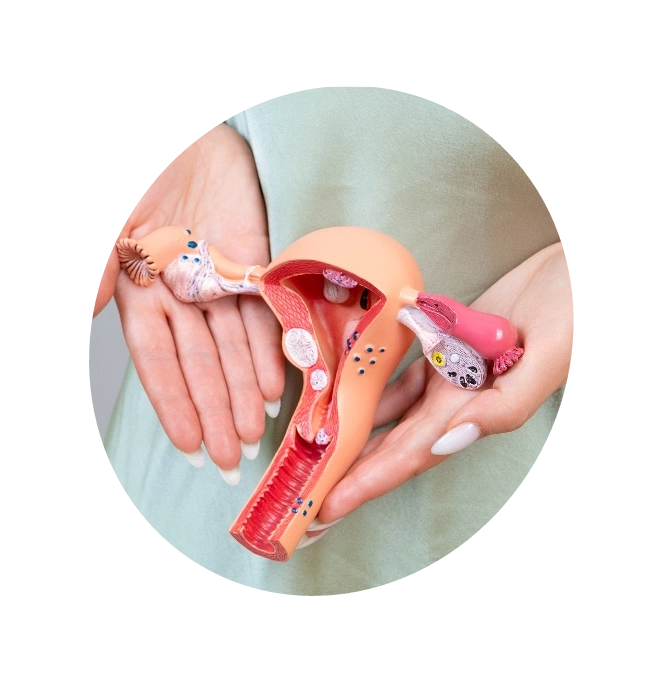What is Endometriosis?
Endometriosis is a common and often painful disorder of the female reproductive system. In this medical condition, a specialized type of tissue that normally lines the inside of your uterus (the endometrium) becomes implanted outside your uterus, most commonly on your fallopian tubes, ovaries, or the tissue lining your pelvis. Rarely, endometrial tissue may spread beyond your pelvic region.
During your menstrual cycle, hormones signal the lining of your uterus to thicken to prepare for a possible pregnancy. If a pregnancy doesn’t occur, your hormone levels decrease, causing the thickened lining of your uterus to shed. This results in menstrual bleeding which is released through the vagina – the monthly period.
When endometrial tissue is located in other parts of your body, it continues to act in its normal way: It thickens, breaks down, and bleeds each month as your hormone levels rise and fall. However, because there’s nowhere for the blood from this mislocated tissue to exit your body, it becomes trapped, and surrounding tissue can become irritated.
Trapped blood may lead to the growth of cysts. Consequently, cysts can cause scar tissue and adhesions to develop, which are abnormal forms of connective tissue that attach organs together. This process can cause pain in the area of this misplaced tissue, usually the pelvis, especially during your period. Endometriosis can also cause fertility problems. In fact, scars and adhesions on ovaries or fallopian tubes can prevent pregnancy.
Endometriosis isn’t the only cause of pelvic pain. Functional ovarian cysts, pelvic infections, and non-gynecologic diseases also may cause pelvic pain. Although ovarian cancer doesn’t usually cause pelvic pain in its early stages, it’s a possibility your doctor should consider. See your doctor for an accurate diagnosis and to target treatment.
Signs and Symptoms of Endometriosis
Endometriosis can range from mild to severe intensity and its severity tends to increase if left untreated. Some women with endometriosis have no signs and symptoms at all, and the disease is discovered only during an unrelated operation, such as tubal ligation. Others may experience one or more of the following signs and symptoms:
Pelvic pain and cramping may begin before and extend several days into your period and may include lower back and abdominal pain.
You may experience pelvic pain during ovulation, sharp pain deep in the pelvis during intercourse, or pain during bowel movements
Inflammatory bowel disease, or urination.
Occasionally, you may experience a heavier flow than normal (menorrhagia) or bleeding between menstrual cycles (
menometrorrhagia).
Menstrual cycle-related problems can lead to a diagnosis of endometriosis, particularly when seeking treatment for infertility.
Some cramping during your period isn’t abnormal. But women with endometriosis typically describe menstrual pain that’s far worse than normal. People usually report that their pain has progressively worsened over time.
Pain is a common symptom of endometriosis. However, the severity of pain isn’t necessarily a reliable indicator of the extent of the condition. Some women with mild endometriosis have extensive pain, while others with more severe scarring may have little pain or no pain at all.
Endometriosis should be accurately diagnosed by a doctor to distinguish it from similar conditions like PID and ovarian cysts that can also cause pelvic pain. Irritable Bowel Syndrome (IBS) is sometimes confused with a condition that has similar symptoms, such as bouts of diarrhea, constipation, and abdominal cramps. Endometriosis can be complicated to diagnose, as it can be often accompanied by certain symptoms of IBS.
Make an appointment with your physician if you experience any signs or symptoms that may be indicative of endometriosis. Finding the root cause of chronic or severe pelvic pain can be a challenge. By detecting the issue early on, you stand a better chance of preventing any further trouble and complications, which can also result in a reduction of potential pain and discomfort.
Causes of Endometriosis
The cause of endometriosis remains mysterious. Scientists are researching how hormones and the immune system impact this disorder, in order to gain a better understanding of its causes.
It has been hypothesized that menstrual blood containing endometrial cells passes back through the fallopian tubes and plants itself there, leading to growth. It has been suggested that endometrial cells may be passed through the bloodstream to other areas in the body. Endometriosis may have a genetic component, making some people more likely to experience the condition due to their family history.
There is a suggestion from some researchers that certain cells in the abdominal area of some women have the capability to differentiate into endometrial cells. These same cells were responsible for the growth of the women’s reproductive organs when she was an embryo. It’s believed that genetic or environmental influences in later life allow these cells to give rise to endometrial tissue outside the uterus.
Risk Factors for Endometriosis
Experts estimate that up to one in 10 American women of childbearing age have endometriosis. The condition is most likely to occur in women who haven’t had children. There may be a genetic predisposition for some women to develop endometriosis.
Rarely, a woman may be at increased risk because of a medical problem that prevents the normal passage of menstrual flow. In addition, there’s some thinking that damage to cells that line the pelvis — caused by a previous infection — can lead to endometriosis.
Endometriosis can affect menstruating women of any age or race and usually takes several years after the onset of menstruation (menarche) to develop. When menstruation ends permanently with menopause or temporarily with pregnancy, the signs and symptoms of endometriosis stop. They can begin again after pregnancy when menstruation resumes. Rarely, hormone replacement therapy after menopause can reactivate the disorder.
Diagnosing Endometriosis
Physicians use a detailed history of your symptoms to accurately diagnose and provide effective relief for pelvic pain, such as endometriosis. Your doctor will perform a pelvic exam to check for any abnormalities, such as cysts on your reproductive organs or scars behind your uterus. Often it’s not possible to feel small areas of endometrial implantation unless they’ve caused a cyst to form.
Other tests to check for physical clues of endometriosis include:
During a vaginal ultrasound, a wand-shaped scanner (transducer) is inserted into your vagina. Pelvis ultrasounds are conducted through the abdomen, where a small scanning device is passed over the abdomen. Both tests use sound waves to provide a video image of your reproductive organs.
Because endometrial implants often cannot be felt or clearly seen in some tests, the only way a doctor can make a definitive diagnosis of endometriosis is through a minor surgical procedure called laparoscopy. Prior to the commencement of the procedure, you will be given a general anesthetic to make you relaxed. Using a special needle, your abdomen is expanded (distended) with carbon dioxide gas so that reproductive organs are easier to see. A small incision near the belly button allows a laparoscope to be inserted for viewing. Laparoscopy is a powerful tool used by surgeons to get an inside look at the pelvic and abdominal area, allowing them to detect endometrial tissue outside of the uterus. If you have endometriosis, laparoscopy will provide you and your doctor with information about the location, extent, and size of the endometrial implants. This information will help your doctor guide you through treatment options.
CA-125 is a blood test used to detect a certain protein that’s commonly found in the blood of women with endometriosis. Although CA-125 commonly reveals an elevation in such blood protein in women with advanced endometriosis, it’s not as sensitive to less advanced diseases. CA-125 doesn’t always perform well as a screening test for endometriosis.
Treating Endometriosis
Treatment for endometriosis is with medications or surgery. The type of treatment prescribed will depend on the intensity of your symptoms and whether you plan to conceive. You and your doctor will decide together what is best for you.
Your doctor may recommend that you take an over-the-counter pain reliever, such as ibuprofen, to help ease painful menstrual cramps. However, if you find that taking the maximum dose doesn’t provide full relief, you may need to try another treatment approach to manage your symptoms.
Supplemental hormones are effective in reducing or eliminating the pain of endometriosis. During a woman’s menstrual cycle, hormonal fluctuations lead to the thickening and breaking down of endometrial implants – resulting in bleeding. If hormonal treatments do not help alleviate your symptoms, it may be worth revisiting the diagnosis of endometriosis or how it is linked to your symptoms.
Hormonal therapies used to treat endometriosis include:
Oral Contraceptives
Birth control pills help control the hormones responsible for the buildup of endometrial tissue each month. With regular use, the pill can make endometriosis-related pain manageable or even non-existent. Most women also have lighter and shorter menstrual flow when they’re taking the pill.
Gonadotropin-releasing Hormone (Gn-RH) Agonists and Antagonists
These medicines are effective in controlling the release of hormones that stimulate ovulation. This action prevents menstruation and dramatically lowers estrogen levels, causing endometrial implants to shrink. Gn-RH agonists and antagonists are an effective treatment for managing endometriosis, putting it into remission, and controlling symptoms over a period of time. These drugs create artificial menopause that can sometimes lead to troublesome side effects, such as hot flashes and vaginal dryness. A low dose of estrogen may be taken along with these drugs to decrease such side effects.
Danazol (Danocrine)
This drug blocks the production of ovarian-stimulating hormones, preventing menstruation and the symptoms of endometriosis. In addition, it impedes the development of the endometrium. However, danazol may not be the first choice because it can cause unwanted side effects, such as acne and facial hair.
This injectable drug is effective in halting menstruation and the growth of endometrial implants, thereby relieving the signs and symptoms of endometriosis. Its side effects can include weight gain and depressed mood.
Although hormone therapies are effective in reducing or eliminating symptoms of endometriosis, they prevent pregnancy. If you are struggling to conceive due to endometriosis, surgical removal of the implants might give you a better chance at success. Endometriosis can cause severe pain, and surgery is often a successful treatment option.
Conservative surgery removes endometrial growths, scar tissue, and adhesions without removing your reproductive organs. Your doctor can choose between laparoscopic or traditional abdominal surgery, depending on the severity of your medical condition. In laparoscopic surgery, a slender viewing instrument (laparoscope) is inserted through a small incision near your navel. The laparoscope is equipped with a laser, a cautery – an instrument that destroys tissue with heat – or small surgical instruments. Assisted reproductive technologies are sometimes preferable to conservative surgery, and doctors often suggest these approaches if conservative surgery is ineffective.
In severe cases of endometriosis, a total hysterectomy and the removal of both ovaries may be the best treatment. Hysterectomy can remove endometriosis, but to ensure it doesn’t return, removing the ovaries is necessary. Surgery should always be a last resort, especially for women of reproductive age. It carries risks and potential side effects, so it’s important to explore all other options before making a decision. You can’t get pregnant after a hysterectomy.
It is not possible to find the perfect remedy for everyone but women suffering from endometriosis can get some, if not complete, relief once they seek treatment. If you’re experiencing persistent pain, try some home remedies for relief while you wait for it to go away. A hot bath or heating pad can help relieve painful, cramping pelvic muscles at the end of a long day and provide much-needed relaxation.
Finding a doctor with whom you feel comfortable is crucial in managing and treating endometriosis. You may also want to get a second opinion before starting any treatment regimen to be sure you know all of your options and the possible outcomes.

